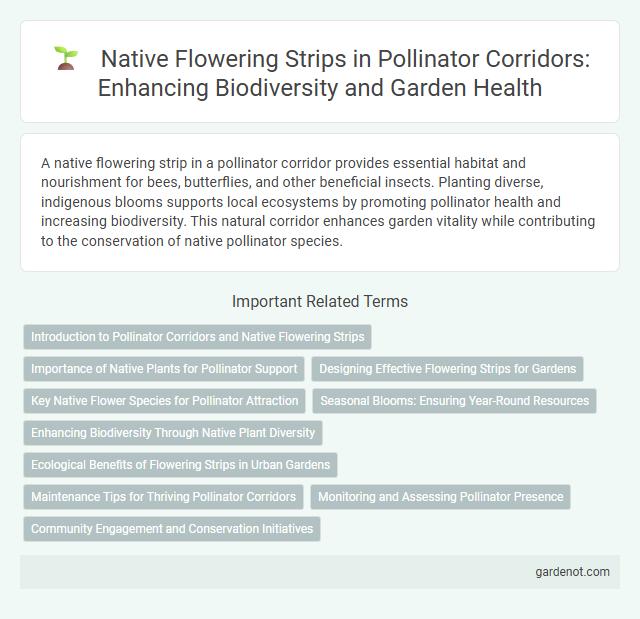A native flowering strip in a pollinator corridor provides essential habitat and nourishment for bees, butterflies, and other beneficial insects. Planting diverse, indigenous blooms supports local ecosystems by promoting pollinator health and increasing biodiversity. This natural corridor enhances garden vitality while contributing to the conservation of native pollinator species.
Introduction to Pollinator Corridors and Native Flowering Strips
Native flowering strips serve as essential components of pollinator corridors by providing continuous sources of nectar and pollen for bees, butterflies, and other pollinators. These strips often contain a diverse mix of indigenous plant species tailored to local ecosystems, enhancing habitat connectivity and supporting pollinator health and biodiversity. Implementing native flowering strips within pollinator corridors encourages sustainable agricultural practices and strengthens ecosystem resilience.
Importance of Native Plants for Pollinator Support
Native flowering strips enhance pollinator corridors by providing essential nectar and pollen resources tailored to local pollinators' nutritional needs. These native plants support diverse pollinator species, including bees, butterflies, and hummingbirds, by offering habitat and continuous bloom periods throughout the growing season. Incorporating native flora strengthens ecosystem resilience and promotes biodiversity in agricultural and urban landscapes.
Designing Effective Flowering Strips for Gardens
Designing effective native flowering strips for gardens involves selecting a diverse mix of local pollinator-friendly plants that bloom sequentially to provide continuous nectar and pollen sources. Incorporate species such as Echinacea purpurea, Solidago canadensis, and Asclepias syriaca to optimize habitat quality and support native bees, butterflies, and other pollinators. Proper site preparation, soil management, and avoiding pesticide use enhance plant establishment and maximize ecological benefits in pollinator corridors.
Key Native Flower Species for Pollinator Attraction
Key native flower species such as Echinacea purpurea, Asclepias tuberosa, and Solidago canadensis play a crucial role in pollinator corridors by attracting diverse pollinators including bees, butterflies, and hummingbirds. These native flowering strips provide essential nectar and pollen resources throughout the growing season, supporting pollinator health and biodiversity. Incorporating a variety of bloom times and flower structures enhances habitat suitability within the pollinator corridor ecosystem.
Seasonal Blooms: Ensuring Year-Round Resources
Native flowering strips with diverse seasonal blooms provide continuous nectar and pollen sources vital for pollinators throughout the year. Incorporating a range of native species that flower in spring, summer, and fall supports the life cycles of bees, butterflies, and other pollinating insects. Maintaining year-round floral resources enhances habitat connectivity within pollinator corridors, boosting biodiversity and ecosystem resilience.
Enhancing Biodiversity Through Native Plant Diversity
Native flowering strips in pollinator corridors boost biodiversity by supporting a diverse range of native plant species, which provide essential habitats and food sources for local pollinators. These native plants promote ecosystem resilience by attracting pollinators such as bees, butterflies, and hummingbirds, crucial for pollination services that sustain agricultural productivity and natural plant communities. Integrating diverse native flowering strips enhances genetic diversity within pollinator populations, contributing to healthier, more stable ecosystems.
Ecological Benefits of Flowering Strips in Urban Gardens
Native flowering strips in urban gardens create essential habitats that support pollinator diversity and increase local biodiversity. These strips enhance ecosystem services by improving pollination rates for nearby plants, contributing to healthier urban green spaces. By providing continuous floral resources, they help sustain pollinator populations, promoting ecological balance within city environments.
Maintenance Tips for Thriving Pollinator Corridors
Native flowering strips require regular maintenance such as periodic weeding and selective pruning to promote healthy growth and maximize bloom duration for pollinators. Monitoring soil moisture and avoiding chemical pesticides help sustain a vibrant habitat that supports diverse pollinator species including bees, butterflies, and hummingbirds. Seasonal reseeding with native wildflower species adapted to local conditions ensures continuous floral resources along the pollinator corridor.
Monitoring and Assessing Pollinator Presence
Monitoring and assessing pollinator presence in native flowering strips involves systematic surveys using transect walks, pan traps, and netting to capture data on pollinator diversity and abundance. Regular observation records help track seasonal and annual changes, providing critical insights into pollinator habitat use and foraging behavior within these corridors. Data integration with environmental factors enhances understanding of ecosystem health and informs adaptive management strategies for pollinator conservation.
Community Engagement and Conservation Initiatives
Native flowering strips foster community engagement by involving local volunteers in planting and maintenance, enhancing awareness of pollinator conservation. These strips serve as vital habitats within pollinator corridors, supporting native bee populations and other beneficial insects critical for ecosystem health. Conservation initiatives centered on native flowering strips improve biodiversity and promote sustainable agricultural practices through habitat connectivity.
Native flowering strip Infographic

 gardenot.com
gardenot.com